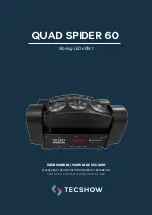
Audio and Ground Connections
You are going to need five 1/4” jack sockets, four mono and one stereo, to connect your PCB
to the outside world. Each jack is connected to its respective 0.1” headers on the PCB. The
stereo jack socket is to be fitted in the Output position. This is because the audio output of the
Filtrex-II is impedance balanced and requires three connections to the outside world. The
stereo one is therefore not being used to carry a stereo signal but a TRS or tip-ring-sleeve
connection. We can use this like we would a true balanced output signal but with full
compatibility with ordinary unbalanced connections too.
The ground pin on each header is always on the right hand side as you look at the board with
the pots facing forwards. This is pin 1 of the header so the ground pin should correspond to
the square pad on the PCB. Each of these pads will be connected to the respective jack
socket’s ground pin, ie. the one that will connect to the barrel of the plug when it is inserted.
On the two pin headers the signal is sent on the furthest left pin of the header, pin 2 on the two
way headers and pin 3 on the three way header.
For each mono socket, it is a good idea to twist the wires together in pairs. Use two different
colours to tell them apart, and try to keep the wiring as short as possible to prevent picking up
hum and other stray fields. You can use screened cable if you wish, and this should be so if
you are using a wooden case to house the Filtrex. The screen must go to pin 1 of each 2-way
header as it carries the ground. Pin 1 should thus connect to the socket's sleeve terminal. Pin 2
should connect to the tip terminal of the socket.
For the stereo (TRS) socket you have three connections to make. If you are wanting to use
screened cable you will need to use special balanced cable which comes with a single screen
that overlaps two identical conductors. Like the other connections pin 1 is the ground and
should be connected to any shield if you are using screened cable. As before this should go to
the sleeve lug of the socket. The audio signal is carried from pin 3 of the header and this
should connect to the tip lug of the socket. Pin 2 is the ground compensation input and should
connect to the ring of the output socket.
I recommend that you use plastic sockets and not ones with a metal mounting bush. This
allows any metal case to float electrically with respect to the socket's ground connection.
However, I do recommend you ground your case in a controlled manner as this will reduce the
likelihood of picking up radiated hum fields from other pieces of equipment and wiring. What
we need to do is tie our case to 0V but not tightly. R126 and the 'CASE' solder pad provide an
easy way of doing this.
Fit a M4 bolt through the rear panel of your metal case. With a washer, spring washer and nut,
fasten a solder tag to it. Solder a piece of insulated wire from the tag to the solder pad 'CASE'
on the PCB. Your case is now grounded.
If you are mounting your PCB to the case via the M3 mounting holes in the top left and top
right of the PCB then you do not need to use the CASE pad. The top right hole, the one next
to the CASE pad, is connected directly to the CASE pad. By simply bolting the board to your
case with metal hardware you will ensure your case is adequately grounded.
15









































